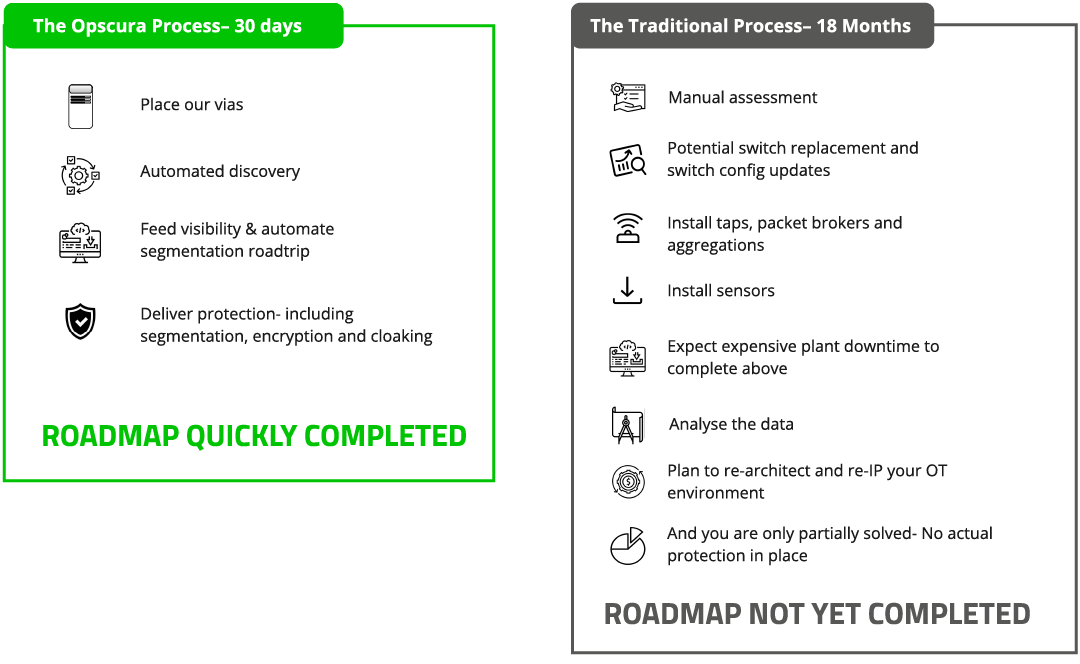Operational technology (OT) is the backbone of many critical industries—manufacturing, energy, transportation, and utilities to name four. These systems, responsible for managing physical processes and industrial control systems (ICS), are vital to day-to-day operations. Any disruption, whether from a cyberattack, equipment failure, or even planned downtime, can lead to significant financial losses, safety risks, and damage to a company’s reputation. Not to mention all the customer, partner, and community frustrations.

The financial toll of OT downtime is staggering. Splunk’s The Hidden Costs of Downtime Report, estimates that downtime and service degradation cost Global 2000 companies $400 billion annually. Moreover, the 2024 State of Operational Technology and Cybersecurity Report reveals that 73% of OT professionals have reported cybersecurity intrusions, while 52% have experienced financial losses due to downtime.
Whether planned or unplanned, the effects of downtime are expensive and far-reaching.
The Hidden Threat: Planned Downtime
Downtime refers to any disruption in the operation of Industrial Control Systems (ICS) and other critical infrastructure—whether it’s unplanned, caused by a cyberattack or equipment failure, or planned, resulting from operational updates including security implementations.
While unplanned downtime from cyberattacks is a known issue, planned downtime for security implementations can be just as disruptive, if not more so. Reconfiguring systems, re-IPing devices, and overhauling networks to install security measures result in long disruptions, halting production and draining resources. Ironically, the cost of this planned downtime can sometimes outweigh that of a cyberattack.
In the effort to prevent unplanned downtime caused by cyber threats, businesses end up enduring debilitating planned downtime.
The problem lies in how security is implemented. Security rollouts typically involve system reconfigurations, device re-IPing, and network overhauls. The result? Disruptions that affect production and debilitate profitability. Plus, customers, partners and stakeholders can be even less sympathetic to these self-inflicted wounds.
This creates a dilemma: the cost of unplanned downtime from a cyberattack is often far smaller than the cost of planned downtime caused by security implementation. The math doesn’t add up.
Traditional security rollouts become a double-edged sword—attempting to protect against one potential risk while creating the certainty of lost productivity and revenue.
Deployment Challenges of Traditional OT Security Solutions
Most OT security solutions on the market come with a hidden cost: requiring roadmaps that require significant planned downtime. Unlike IT security tools, which are designed for flexible, software-driven environments, many OT security implementations require extensive reengineering of industrial networks. This process often includes re-IPing devices, modifying PLC software, and overhauling network architectures—changes that can take weeks or even months to complete.
During this time, production is disrupted, operations slow down, and the company is left vulnerable to cyberattacks. For example, a pulp and paper plant faced an estimated $1 million in costs due to network reengineering, PLC software modifications, and the resulting downtime required to implement a security solution. This was simply put, cost-prohibitive and rejected as a viable solution by operations.
Adding to the challenge, many organizations attempt to apply IT security tools to OT environments, only to find them incompatible. Applying IT-based security solutions can introduce operational disruptions, latency issues, and incompatibility with legacy systems—further complicating deployments and increasing downtime.
The irony is clear: in an effort to prevent unplanned downtime caused by cyber threats, businesses are forced to endure massive planned downtime due to security implementations. And every day spent in deployment limbo increases the risk of a real cyberattack.
A New Approach: Rapid, Zero-Downtime OT Security
What if there were a way to secure OT environments without this painful downtime? Opscura delivers exactly that—a paradigm shift in OT security.
Our drop-in security solution enables organizations to microsegment large facilities in just hours, eliminating the need for re-IPing, reconfigurations, or network reengineering. This means you can instantly secure your OT environment with deep visibility and actual protection –all without the operational disruptions (aka: planned downtime) that typically come with security rollouts.
With Opscura, businesses can sidestep both the downtime of security implementations and the risk of cyberattacks. Our solution integrates seamlessly into existing infrastructure, providing a rapid, cost-effective way to strengthen security without sacrificing productivity.

Securing OT Without the Downtime
The cost of OT downtime, whether planned or unplanned, is undeniable. Both traditional IT security solutions and conventional OT security approaches often fail to meet the unique needs of industrial environments. IT-centric security tools introduce latency and operational disruptions, while traditional OT security solutions demand extensive network overhauls, re-IPing, and reconfigurations—resulting in prolonged, costly planned downtime.
Opscura offers a smarter approach. Our zero-downtime security solution provides protection in hours without the need for disruptive reengineering. Businesses can secure their OT environments in hours, not months, ensuring safety, security, and operational efficiency without sacrificing uptime.
Don’t wait for a cyberattack or an operational breakdown to force your hand. If your security rollout is stalled due to costly downtime or complex implementation, we can help. Contact us today to learn how we can help you secure your OT systems, minimize downtime, and protect your critical infrastructure—without the disruptions of traditional solutions.
